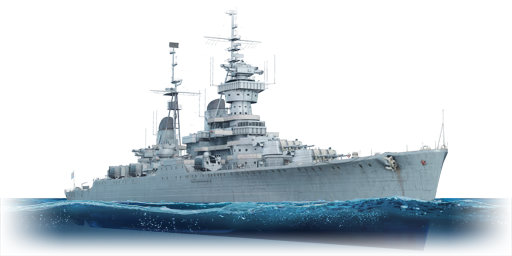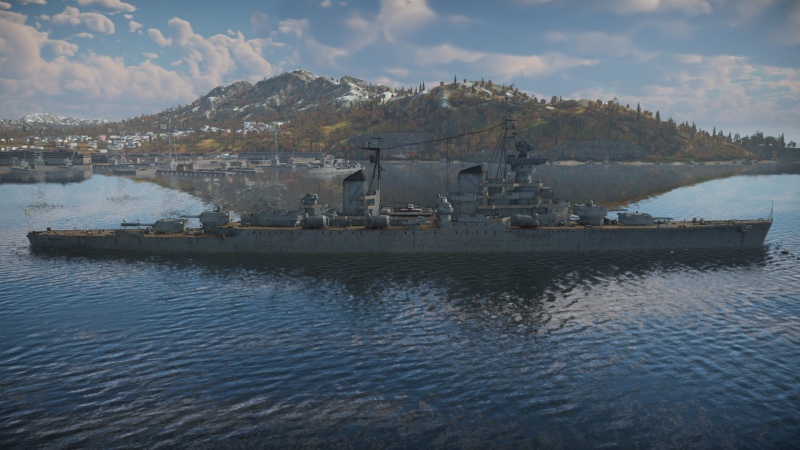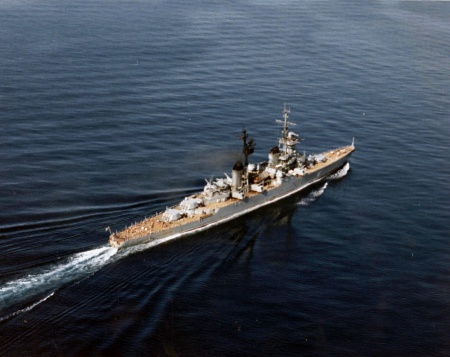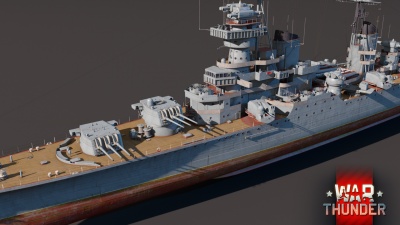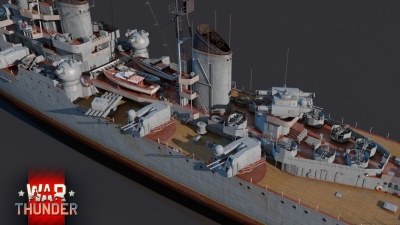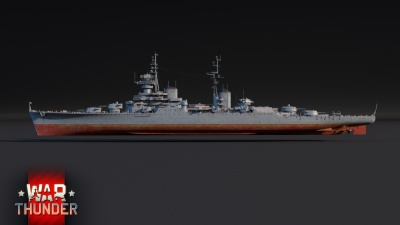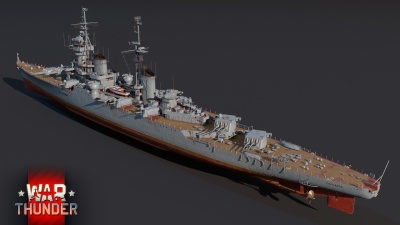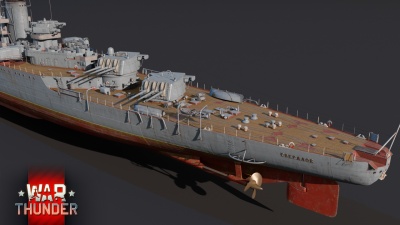Difference between revisions of "Sverdlov"
(→History) |
(added missing info) (Tag: Visual edit) |
||
| Line 11: | Line 11: | ||
=== Survivability and armour === | === Survivability and armour === | ||
{{Specs-Fleet-Armour}} | {{Specs-Fleet-Armour}} | ||
| − | + | While the armour is not enough to protect you from semi-armour-piercing and armour-piercing shells, it is still enough to prevent major damage from being easily inflicted by every shell that comes your way. Destroyers and any HE shell will have trouble with anything belowdecks, as the main battery ammunition, engines, and transmissions are all protected by 100 mm of rolled homogenous armour. The front and rear belt armour are only 20 mm and 30 mm thick RHA; while this isn't very useful, there is also not much in those areas that can damaged besides the steering gear in the stern. The ammo elevators are protected by 130 mm RHA, while the turrets themselves have 175 mm thick fronts. The turret sides and rear are much thinner but this isn't a major problem as long as you keep your main batteries pointed towards whatever is shooting at you. Secondary batteries have 20 mm thick antifragmentation armour, which is only useful against smaller autocannons and strafing aircraft. Anti-aircraft batteries have no armour at all and are often knocked out. The bridge has a 130 mm thick belt surrounding it but can still be knocked out by rounds exploding above and below it. | |
=== Mobility === | === Mobility === | ||
{{Specs-Fleet-Mobility}} | {{Specs-Fleet-Mobility}} | ||
| − | + | The Sverdlov, just as any of his twin ships ([[Chapayev]] and [[Zheleznyakov]]) is a cruiser with destroyer feelings. Fast for a cruiser its size, very responsive and agile but the size drastically reduces the mobility of it compared to any destroyer. It should be notted that it is much more agile than any of the previous cruisers seen in the tree. | |
=== Modifications and economy === | === Modifications and economy === | ||
| Line 26: | Line 26: | ||
{{main|152 mm/57 B-38 (152 mm)}} | {{main|152 mm/57 B-38 (152 mm)}} | ||
| − | + | The Sverdlov is the second Soviet cruiser with access to the formidable 152 mm/57 B-38 (152 mm). Once again, we see potent and powerful 152 mm fast-firing cannons that can objectively destroy anything it faces. As seen in his twins, the 152 mm have access to four types of ammunition: HE, SAPBC, APCBC and HE-TF. The HE round lacks penetration power, the explosive filler in it is more than enough to decimate enemy lightly armored vessels in seconds. Our next round is SAPBC, a mid-point between explosive power and penetration power. This round is particularily useful when facing medium armored vessels or vessels with fragmentation protection as this round will most of the time explode inside the hull and not right away while touching the hull. We can also see APCBC. This round is an essential tool when fighting heavily armored cruisers and battleships. While it has a significantly reduced explosive filler compared to other round, it increases the combat capabilities of the Chapayev against heavily armored cruisers. While using APCBC, aiming at critical components is crucial. Aiming at ammunition, engine compartments and any other components are to be targetted while using this rounds as the reduced filler will not cause as much damage. | |
=== Secondary armament === | === Secondary armament === | ||
| Line 32: | Line 32: | ||
{{main|100 mm/56 SM-5-1 (100 mm)}} | {{main|100 mm/56 SM-5-1 (100 mm)}} | ||
| − | + | The Sverldov is the second of the Soviet cruisers with access to 100 mm/56 SM-5-1 (100 mm). While these turrets are very similar to the [[130 mm/58 SM-2-1 (130 mm)]], they do have a reduced performance due to reduced caliber. They have the exact same use as when used in the [[Spokoinyy]], deliver high amount of rounds at surface targets and have a very powerful AAA. It is nothing new that this weapon system has a very high ROF for the caliber it is (roughly ~30 RPM considering it is a two cannon mount), it has half of what cannons like the [[100 mm/55 MLE model 53 (100 mm)]] have (~60 RPM). | |
| + | |||
| + | However, compared to the [[Chapayev]], the turret number is increased. Insted of only four turrets we have six turrets. If we do the maths, we can figure out the amount of rounds the Sverdlov can put in the air with this weapon system. As already said, the cannons have an RPM of ~30. If we multiply that by six we get ~1800 RPM, ~600 RPM more than the Chapayev. The use of this system is pretty straight forward: put as many rounds in the air as humanly possible to counter enemy aircraft. But for this we have a trick that makes this task easier, access to HE-VT*. If a single 100 mm hit can already cause significant damage to an aircraft, multiply that by 12. | ||
=== Anti-aircraft armament === | === Anti-aircraft armament === | ||
| Line 38: | Line 40: | ||
{{main|V-11 (37 mm)}} | {{main|V-11 (37 mm)}} | ||
| − | + | As already seen in previous Soviet vessels, 37 mm auto-cannons are a must have. But Sverdlov takes the 37 mm to the next level. As we have seen before, ships tend to have between 6x-10x single mount 37 mm auto-cannons. This was changed with the Chapayev with making double mounts, increasing the ammount of 37 mm to 28x and now increased to 32x. | |
=== Additional armament === | === Additional armament === | ||
| Line 44: | Line 46: | ||
{{main|53-39 (533 mm)}} | {{main|53-39 (533 mm)}} | ||
| − | + | Compared to all the other Pr.68, the Sverdlov is the only one with access to torpedo tubes. It is armed with 2x 5-tube torpedo launchers, one located at port and the other at starboard. It uses the not new torpedo, the 53-39 533 mm torpedo. These are your main weapon against heavily armoured threats or when doing sneak attacks at distance. They have a max range of 4 km (10 km with torpedo mode) and can be used at almost point blank, the torpedo must travel 50 m at minimum to be armed. These torpedoes are one of the fastest ones seen at the battle rating (94 km/h), making it easier to aim at long ranges. However, the speed is drastically reduced if torpedo mode is active as it trades speed for range. | |
== Usage in battles == | == Usage in battles == | ||
| − | + | The Sverdlov is a Chapayev but better, and as such, it should be used as such. The potent firepower is enough to destroy a wide variety of targets but to also provide a very devastating and powerful AA coverage to allied ships, specially at long ranges. The Sverdlov can be used as a brawler when in CQC maps, although not recommended, it is very capable to do so. The armor and the amount of firepower it carries is more than enough to obliterate any ship at close-quarters. | |
=== Pros and cons === | === Pros and cons === | ||
Revision as of 18:06, 18 August 2021
Contents
Description
The Pr.68-bis, Sverdlov, 1952 is a rank Soviet light cruiser with a battle rating of (AB), (RB), and (SB). It was introduced in Update 1.97 "Viking Fury".
General info
Survivability and armour
While the armour is not enough to protect you from semi-armour-piercing and armour-piercing shells, it is still enough to prevent major damage from being easily inflicted by every shell that comes your way. Destroyers and any HE shell will have trouble with anything belowdecks, as the main battery ammunition, engines, and transmissions are all protected by 100 mm of rolled homogenous armour. The front and rear belt armour are only 20 mm and 30 mm thick RHA; while this isn't very useful, there is also not much in those areas that can damaged besides the steering gear in the stern. The ammo elevators are protected by 130 mm RHA, while the turrets themselves have 175 mm thick fronts. The turret sides and rear are much thinner but this isn't a major problem as long as you keep your main batteries pointed towards whatever is shooting at you. Secondary batteries have 20 mm thick antifragmentation armour, which is only useful against smaller autocannons and strafing aircraft. Anti-aircraft batteries have no armour at all and are often knocked out. The bridge has a 130 mm thick belt surrounding it but can still be knocked out by rounds exploding above and below it.
Mobility
The Sverdlov, just as any of his twin ships (Chapayev and Zheleznyakov) is a cruiser with destroyer feelings. Fast for a cruiser its size, very responsive and agile but the size drastically reduces the mobility of it compared to any destroyer. It should be notted that it is much more agile than any of the previous cruisers seen in the tree.
Modifications and economy
Armament
Primary armament
The Sverdlov is the second Soviet cruiser with access to the formidable 152 mm/57 B-38 (152 mm). Once again, we see potent and powerful 152 mm fast-firing cannons that can objectively destroy anything it faces. As seen in his twins, the 152 mm have access to four types of ammunition: HE, SAPBC, APCBC and HE-TF. The HE round lacks penetration power, the explosive filler in it is more than enough to decimate enemy lightly armored vessels in seconds. Our next round is SAPBC, a mid-point between explosive power and penetration power. This round is particularily useful when facing medium armored vessels or vessels with fragmentation protection as this round will most of the time explode inside the hull and not right away while touching the hull. We can also see APCBC. This round is an essential tool when fighting heavily armored cruisers and battleships. While it has a significantly reduced explosive filler compared to other round, it increases the combat capabilities of the Chapayev against heavily armored cruisers. While using APCBC, aiming at critical components is crucial. Aiming at ammunition, engine compartments and any other components are to be targetted while using this rounds as the reduced filler will not cause as much damage.
Secondary armament
The Sverldov is the second of the Soviet cruisers with access to 100 mm/56 SM-5-1 (100 mm). While these turrets are very similar to the 130 mm/58 SM-2-1 (130 mm), they do have a reduced performance due to reduced caliber. They have the exact same use as when used in the Spokoinyy, deliver high amount of rounds at surface targets and have a very powerful AAA. It is nothing new that this weapon system has a very high ROF for the caliber it is (roughly ~30 RPM considering it is a two cannon mount), it has half of what cannons like the 100 mm/55 MLE model 53 (100 mm) have (~60 RPM).
However, compared to the Chapayev, the turret number is increased. Insted of only four turrets we have six turrets. If we do the maths, we can figure out the amount of rounds the Sverdlov can put in the air with this weapon system. As already said, the cannons have an RPM of ~30. If we multiply that by six we get ~1800 RPM, ~600 RPM more than the Chapayev. The use of this system is pretty straight forward: put as many rounds in the air as humanly possible to counter enemy aircraft. But for this we have a trick that makes this task easier, access to HE-VT*. If a single 100 mm hit can already cause significant damage to an aircraft, multiply that by 12.
Anti-aircraft armament
As already seen in previous Soviet vessels, 37 mm auto-cannons are a must have. But Sverdlov takes the 37 mm to the next level. As we have seen before, ships tend to have between 6x-10x single mount 37 mm auto-cannons. This was changed with the Chapayev with making double mounts, increasing the ammount of 37 mm to 28x and now increased to 32x.
Additional armament
Compared to all the other Pr.68, the Sverdlov is the only one with access to torpedo tubes. It is armed with 2x 5-tube torpedo launchers, one located at port and the other at starboard. It uses the not new torpedo, the 53-39 533 mm torpedo. These are your main weapon against heavily armoured threats or when doing sneak attacks at distance. They have a max range of 4 km (10 km with torpedo mode) and can be used at almost point blank, the torpedo must travel 50 m at minimum to be armed. These torpedoes are one of the fastest ones seen at the battle rating (94 km/h), making it easier to aim at long ranges. However, the speed is drastically reduced if torpedo mode is active as it trades speed for range.
Usage in battles
The Sverdlov is a Chapayev but better, and as such, it should be used as such. The potent firepower is enough to destroy a wide variety of targets but to also provide a very devastating and powerful AA coverage to allied ships, specially at long ranges. The Sverdlov can be used as a brawler when in CQC maps, although not recommended, it is very capable to do so. The armor and the amount of firepower it carries is more than enough to obliterate any ship at close-quarters.
Pros and cons
Pros:
- Very effective AA suite with 100 mm VT shells and 37 mm automatic guns
- Enough armour to withstand multiple shots
- 12 x 152 mm cannons with various types of ammunition
Cons:
- Difficult to manoeuvre
- After exhausting the first-stage storage of the main guns, the reload speed is significantly reduced
- If the torpedoes are loaded they can cause an explosion if they are hit, disabling or even sinking the ship
History
The Soviet cruiser Sverdlov was the lead ship of the Sverdlov class of light cruisers built for the Soviet navy in the 1950s. Being conventional cruisers, they were designed to function as bluewater ships with the ability to perform commerce raiding duties if required, similar to the German pocket battleships and battlecruisers. The ships inherited the hulls of the previous Chapayev class, but carried an improved armament and new sensor systems. Sverdlov was commissioned in 1952, and spent most of her operational career making visits to various foreign ports and countries. She was eventually retired in the late 1970s and scrapped shortly before the collapse of the Soviet Union.
Design and development
After the construction of the Chapayev class (Project 68), the Soviet Union began the development of an improved iteration of the ship, to be known as the Sverdlov class or Project 68bis. A total of 40 ships were intended to be built, along with the larger Stalingrad-class battlecruisers and Soviet aircraft carriers. As well, the ships were intended to be capable of commerce raiding, as shown by the conspicuous success of the German commerce raiders during World War II. As a result, the ships were the largest cruisers ever built by the Soviet navy up to that time (and largest until the introduction of the Kirov-class battlecruisers), displacing 16 640 tons. Because the Soviet Leader Stalin had been a supporter of the program, his death in 1953 saw the total number of ships cut to 14. The lead ship, Sverdlov, was laid down in October of 1949 and completed by May of 1952.
Sverdlov displaced 16 640 tons full and had a crew complement of 1250 officers and men. Her main armament consisted of twelve 6-inch (152 mm) guns in four triple turrets, similar to the British Crown Colony-class and American Cleveland-class. Despite this, the Sverdlovs were still inferior in armament to the American Baltimore-class and Des Moines-class cruisers that were then in service. The ships had a heavy anti-aircraft battery of twelve 100 mm guns in twin turrets, and 32 37 mm anti-aircraft guns in twin turrets. The ships also carried two quintuple torpedo tubes on their beam. Powered by steam turbines developing 118 000 shaft horsepower, the Sverdlov could make 32.5 knots (60 km/h) and had a range of 9000 nautical miles.
Operational history
The Sverdlov joined the Soviet 4th Fleet in 1952 after her commissioning, and soon after attended the coronation review of Queen Elizabeth II at Portsmouth. Soon after, she visited Portsmouth again as well as the Dutch port of Rotterdam. She received a major overhaul in 1960 before being laid up and decommissioned. In 1972, she was reactivated again, and visited several European ports before being retired one final time in 1978. By this time, the gun-cruiser nature of the Sverdlovs had made them highly obsolete. As a result, she was sold to an Indian ship-breaker company in 1991, and scrapped by 1993. Out of all the Sverdlov-class cruisers, only Mikhail Kutuzov survives to this day as a museum ship.
Devblog
The Project 68bis light cruisers were a serious modernisation of the Project 68K ships (one of which, the Chapaev light cruiser, you know well). The essence of all planned improvements was simple: to apply all the accumulated military experience and technical achievements as soon as possible to make the light cruisers better in every way. In the course of the modernisation process, the anti-air weaponry was significantly improved, torpedo armament was added, and the armour and stability of the ships were upgraded. The engineers paid special attention to the protection for the crew, which was increased, by the way. All uncovered battle stations received armour or some other kind of protection, and it became possible to move from bow to rear without going out onto the open sections of the deck.
The height of the freeboard increased, which provided ships of this class with better weather resistance and greater range. In keeping with the changes to the naval warfare doctrine, the Project 68bis light cruiser benefited from significant self-sustainment of up to 30 days, and also its sailing range was increased to 9,000 miles. The need for these improvements was so great that the building of the first Project 68bis light cruisers had begun even before the complete project documentation was agreed upon. The leading ship of the series, the Sverdlov, was launched in the summer of 1950, and a short while later, she was put into service as a part of the Baltic Fleet. The Sverdlov light cruiser carried out combat duties in the waters of the Baltic Sea and Atlantic Ocean until her lay-up in 1978. In 1989, the ship was removed from storage, disarmed, and sold to India for scrap metal.
Media
See also
Links to articles on the War Thunder Wiki that you think will be useful for the reader, for example:
- reference to the series of the ship;
- links to approximate analogues of other nations and research trees.
External links
References
- Clarke, A. (2018, June 01). Sverdlov Class Cruisers, and the Royal Navy's Response. Retrieved January 20, 2021, from http://globalmaritimehistory.com/sverdlov_class_rn_response/
| USSR light cruisers | |
|---|---|
| Imperial Russia | |
| Svetlana-class | Krasny Krym* · Krasny Kavkaz* |
| * Laid down by Imperial Russian Navy; Finished and renamed by the USSR | |
| Project | Soviet Union |
| Pr.26 | Kirov · Voroshilov · Maxim Gorky |
| Pr.68 | Chapayev · Zheleznyakov |
| Pr.68-bis | Sverdlov · Mikhail Kutuzov |
| Pr.68-bis-ZiF | Shcherbakov |
| Lend-Lease | USA |
| Omaha-class | Murmansk |
| Trophies | Italy |
| Condottieri-class | Kerch |


